Starting an herb garden, I discovered somewhat by chance, is a gift to yourself that keeps on giving. As a chef and cookbook author, I used plenty of herbs – my vegetable garden had an oregano plant here, a thyme plant there. But while they were always appreciated, they were haphazard at best. When I was asked to teach a class about growing and cooking with herbs, I knew I needed to step up my game.
I viewed some gardens online and visited a few local herb gardens. I also reflected on how to personalize it based on my interests. The result: a circular bed in the middle of my vegetable garden, divided into four specialized sections – culinary herbs, tea herbs, cocktail herbs, and medicinal herbs. Inside the circle, I placed a small outdoor table and a few chairs.
To start the culinary section, I replanted sections of oregano, thyme, and chives from elsewhere in my yard. Mermaid Farm in Chilmark was selling mini herb plants for fifty cents apiece, so I picked up four baby dill plants, one Thai basil, and a summer savory, which I love paired with summer green beans. Total cost: $3.
The bounty began in the spring and early summer, when I snipped thyme, mint, basil, oregano, or dill. But I was also experimenting with some more unusual herbs, including lovage and lemongrass. Later, blue borage blossoms and bright yellow-orange calendula flowers, and eventually lavender and multi-colored nasturtium blooms, created an artistic toolbox for the kitchen. Used in both catering jobs and for pure home enjoyment, these gorgeous edible flowers, torn into petals or used whole, brightened everything from appetizers to salads and desserts.
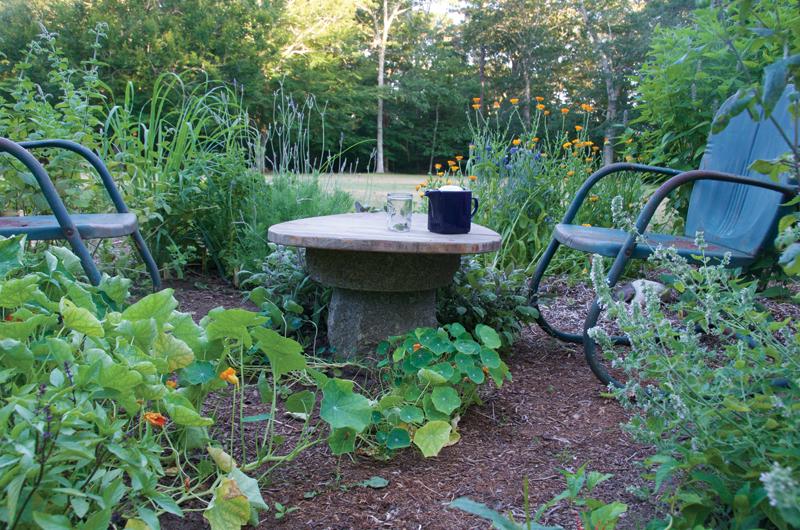
As I picked and garnished, I kept a sheet on the refrigerator, noting each time I picked an herb or flower and the dish in which it was used. An herb butter with chives, tarragon, parsley, and lemon zest for fish. A fresh lemonade with lemon verbena, lemon thyme, and mint, garnished with flowers. Gazpacho enlivened with chives and basil. Local lamb kofta on skewers with mint and parsley. Herbal water with citrus, mint, and lemongrass. By the end of July, I had added six sheets. The variety meant there was something for every meal.
As late as Thanksgiving I not only still had parsley, sage, thyme, and rosemary with which to scent my stuffing and holiday dishes, but also still out there ready for use were fragrant lemongrass, edible flowers, chives, mint, oregano, cilantro, lemon verbena, and even a few precious basil leaves.
I was familiar with kitchen herbs, but I had no idea what to plant in the medicinal section. Vineyard herbalistand author Holly Bellebuono gave me surplus sections of anise hyssop, catnip, and bee balm from her own garden – candidates for both the medicinal and tea sections. My friend Jessica, who I bumped into at a garden center, gave me two borage plants and a pair of calendula plants, which she separated from her planting packs of six. Though just four plants altogether, they exploded with dozens and dozens of the aforementioned edible flowers. Two echinacea plants rounded out the medicinal section.
At one of the larger off-Island garden centers I found lemongrass and stevia seedlings, both annuals. I bought two of each to divide between the cocktail and tea sections. (Not that it really mattered which sections had what, since I could pick from any of them.) Stevia is a natural, no-calorie sweetener that usually comes packaged at the supermarket. I could now experiment myself with the sweet leaves. The lovely fragranced lemongrass, which I had once seen thrive in another Vineyard garden, is wonderful in teas and Asian dishes, and makes one hell of a simple syrup combined with ginger for cocktails. A few basil seedlings, with which I hoped to recreate that noteworthy basil gimlet offered at the Red Cat restaurant in Oak Bluffs, and one pineapple sage also went into the cocktail section.
Each plant took just minutes to get into the ground. Dig the hole, mix in a little compost, tamp down the soil, water. As soon as I began planting, I realized I had a spot to sit and enjoy. One warm evening I brought out two garden rhubarb-raspberry tequila cocktails on a tray and yogurt tzatziki dip with pita bread. I pinched two sets of shapely purplish-green anise hyssop leaves to garnish the drinks. My husband and I sipped and nibbled and relaxed. As you might guess, this started a trend.
When I could steal a few moments, I sat in my new spot to write. I observed the herbs growing into a variety of shapes and sizes and shades of green. In the tea garden, the stevia was growing into one Empire State Building. The fuzzy-shaped pale-green chamomile plant spread out close to the ground. The lemongrass grew over four feet tall, grassy and
elegant. The anise hyssop that received the last of my own compost was bushy and a bit out of control.
I also noticed how unmistakably happy I felt each time I sat in the middle of my herb garden. The calendula flowers – like bright mini suns – kept smiling at me. The herbs stood ready to offer their services, with the power to heal, spice up or flavor foods, or offer solace. I knew there was so much more I had yet to discover, and they were here to teach me. Off my garden rocker, maybe, but with the simple act of planting an herb garden I felt welcomed into another world.
Tips from a Pro
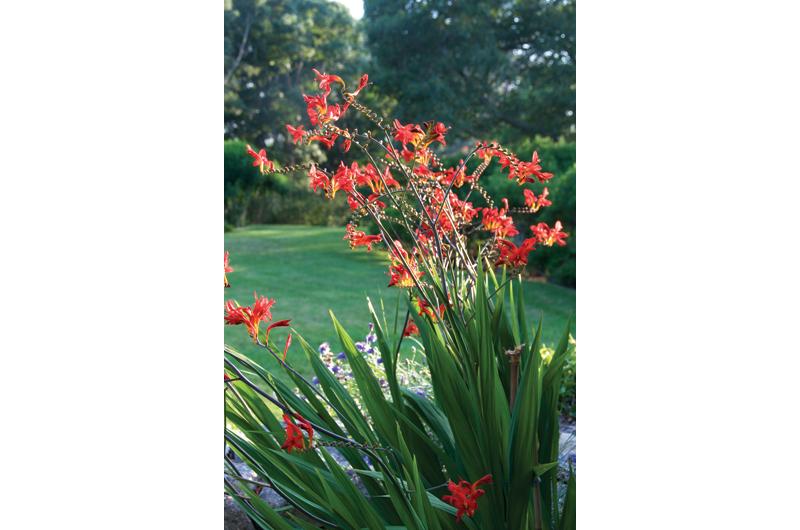
“Do you know how many people skip the herbs in a recipe because they don’t get it?” says Roxanne Kapitan of Oakleaf Landscape and Middletown Nursery, where she oversees the planting of edible gardens and orchards like the magical one I visited with her in West Tisbury. “They have no idea why herbs are so essential to the flavor of the dish.”
The good news is it’s an easy problem to solve. Kapitan, who twenty years ago traded the fluorescent lights and weekly departures from Logan Airport of her government job for the farming life, says all you need is a bit of space and a little compost. Compared to vegetables or flowers, an herb garden is easy to maintain as herbs are generally not bothered by insects or other pests, so little needs to be done after the initial planting, aside from occasional watering. “Whether it’s a few simple potted herbs or an extended herb garden, the rewards are enormous,” she says. “And it’s really very healing – I can’t say that enough. Whatever is going on in your life, you’re going to feel better after you garden, even if your knees hurt.”
There are, however, some things she says to keep in mind while planning your own herb garden.
The Plot: For a perennial herb garden choose a stable section of your garden with six to eight hours of sun and room for the plants to expand.
Location, Location: Consider the full-grown height and width of each herb before planting. Some herbs, such as sage or lavender, will need more room accordingly as they grow each year. Taller perennial herbs, such as chives and oregano, should be planted toward the back of an herb garden. “If you plant chives in front of thyme, you are never going to see your thyme.”
Temporary Help: If your perennial garden looks sparse, you can temporarily supplement it with annual herbs, such as basil or parsley. Plant them in between the bare spots.
Compost Happens: Compost is the only soil addition Kapitan uses when planting, avoiding even organic granular fertilizers except in the poorest of soils. Mix about one yogurt-sized container of compost into the soil at the bottom of a hole for an herb from a four-inch pot, or three yogurt containers for larger plants. “You want to put compost where the roots are, that’s the key. That’s going to boost the growth of your herbs more than anything else. If you spread it over the top of your garden, you could end up giving your weeds a good boost.”
Consider the Container: Annual herbs, which typically don’t have large root systems, are perfect for containers on the patio or outside the kitchen, along with dill, chervil, or cilantro. “Halfway buried pottery gives a nice cottage garden accent,” she explains. They can serve dual purposes. A rosemary plant in a pot can be brought inside during winter. Mint, which is best contained anyway, can be cut back after the season and stored in a basement corner and watered maybe once a month.
Style Point: Include some edible flowers throughout the herb garden, for both visual effect and harvest. “It’s just delightful to look at. I can’t say enough about calendula and
nasturtium.”
Final Touches: Every Oakleaf Landscape edible garden designed by Kapitan features a granite bowl, such as a birdbath, with a ring of lavender around it in the center of the garden. Another of her trademarks: placing lemon verbena plants at garden entrances. They act as aroma sentries, she says.
One Herb to Rule Them: “It’s so individual,” Kapitan says of helping clients decide which herbs to grow. But of her own favorites, parsley is number one. “No matter what’s ailing you, after you eat parsley you feel better.”
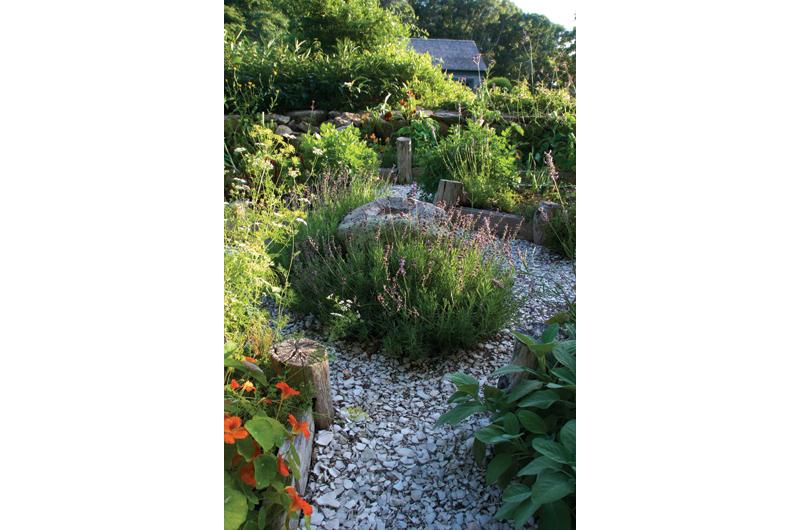
Gardening for Tea
After touring Christa Fischer’s tea garden on a very hot summer day, we sat down for a generously offered sample of iced lavender, chamomile, and lemon verbena tea. My lucky day.
“It’s a misconception you have to dry herbs for tea,” says Fischer, who is a West Tisbury School teacher and member of the Fischer clan at Flat Point Farm. The idea for a tea-specific garden had been percolating for about a dozen years, which is how long she’s owned a book called Herbal Tea Gardens. But about three years ago she noticed that a small, roughly eight-by-ten-foot garden bed sometimes used by her husband and daughter was weedy and neglected. She took it over, and with about fifteen different herbs growing – she’s always trying new ones – began to personalize teas depending on the day, mood, time of year, even ailment. The freshness adds a vibrancy you don’t always get from dried teas, she says.
Common herbal teas like chamomile and mint have a place in this garden, as does lavender, lemon balm, pineapple mint, and lemon verbena, which when crushed gives off a fresh herbal scent of lemon. Bergamot, also known as bee balm, may be the closest to a traditional tea growing in her garden. A native American herb, it was used in colonial times as a patriotic substitute for imported tea after the passage of the Tea Act in 1773 led to widespread boycotts. The most recent additions are several varieties of saw-tooth mountain mints she found online from Tripple Brook Farm and RareFind Nursery. Strictly Medicinal Seeds is another source she has used.
Holy basil, also called Tulsi after an Indian goddess, is one of Fischer’s favorites for tea. It’s been used in India for thousands of years for its therapeutic value, from stress reduction to digestive complaints. “I feel like when I drink it, it’s calming, but it also makes you very clear and focused.”
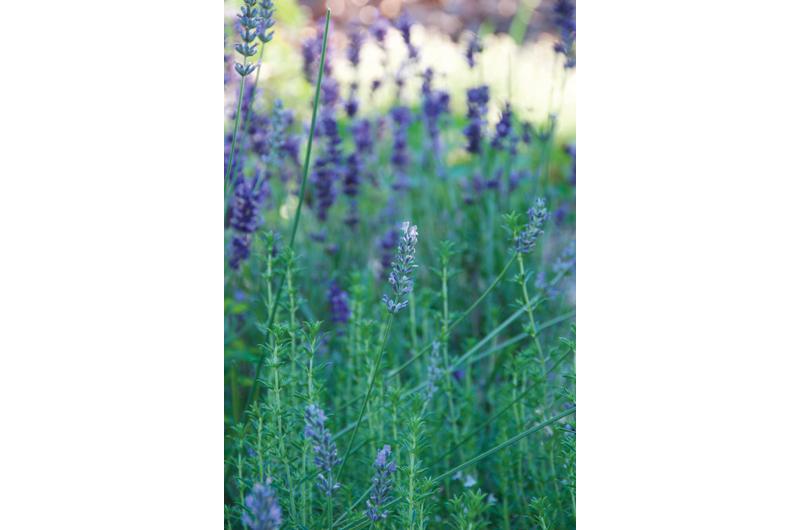
Another, motherwort, is beneficial for mothers and is also good to drink in the summer if you have a lot of guests, though it’s somewhat bitter. Fischer tells a story of the day she looked in the garden for a complement to brew with it. She chose the lemon balm. Later, she says, when she looked up what herbs traditionally pair with motherwort, lemon balm was noted. “I let them sort of speak to me when I make a tea.”
The garden reaches its full glory around July, when many of the herbs produce edible flowers. Borage, for one, produces dozens of tiny star-shaped, purplish-blue flowers with a faint cucumber flavor and multiple uses. “Borage flowers are said to give courage and happiness,” she says. “I always tell the kids they should eat a flower.”
Fischer still buys store-bought tea, such as green or black tea. “I’m just a tea-aholic,” she says, but “it’s a pleasure in the summer to have your own tea, and in January there’s nothing like it.”
At the end of the season, she dries herbs in an oven dehydrator. A favorite combination is dried Tulsi, lavender, lemon balm, lemon verbena, and one of the mints. This year’s winter mix consisted of lemon verbena, lemon balm, and anise hyssop, which she chose for its purifying qualities. Fischer says she hoped that when she re-opened the tea in January, the purifying hyssop would be like a “reset button” for the New Year. Another benefit: drinking these teas on cold winter days “makes you feel like you are in a garden.”

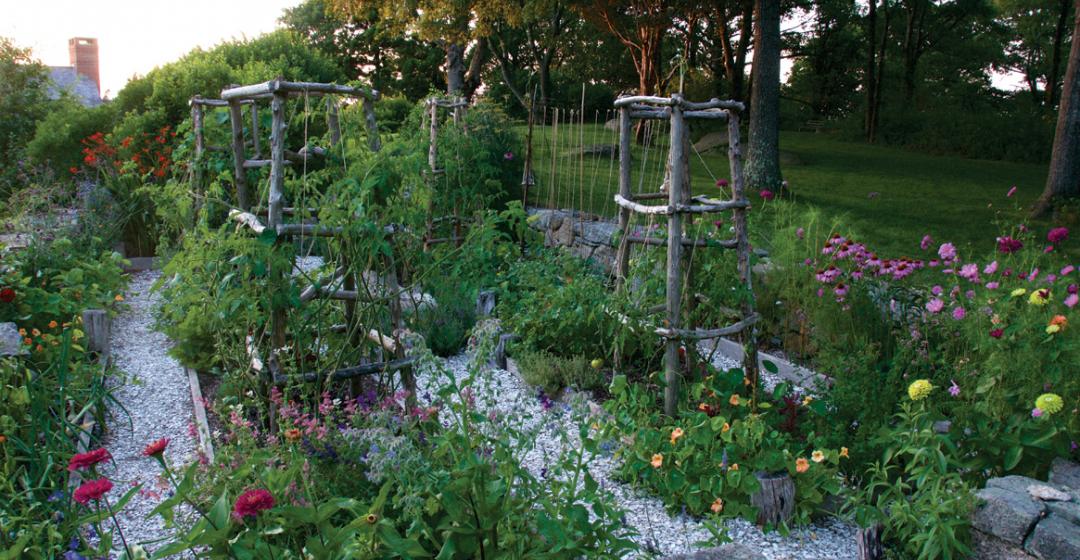


 1 comment
1 comment


Comments (1)